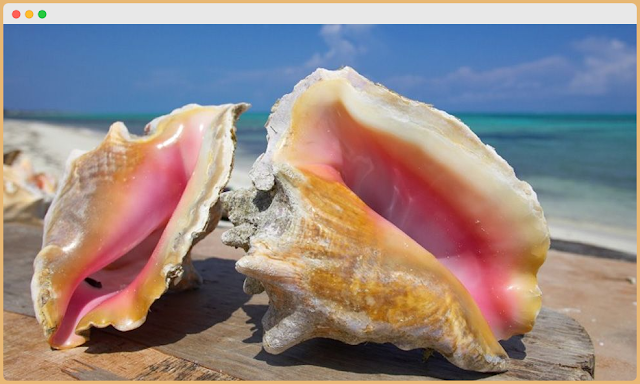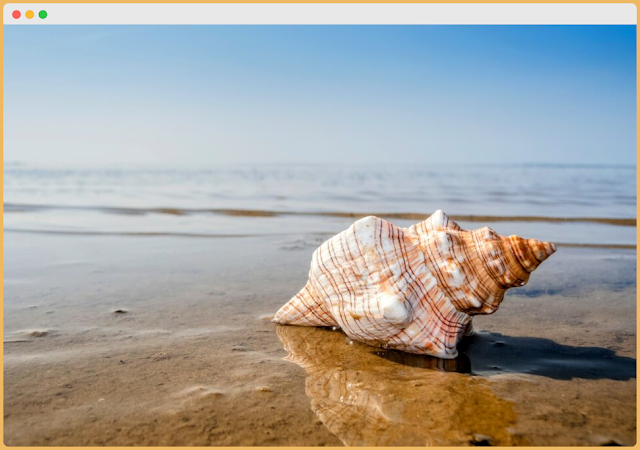
Sea shell
Florida, often referred to as the "Sunshine State," is not only renowned for its stunning beaches and warm climate but also for its abundant marine life, including a diverse array of conch shells. These exquisite treasures of the sea have captivated the hearts of beachcombers, collectors, and nature enthusiasts for generations.

List of Conch Shell in Florida
.webp) |
List of Conch Shell in Florida |
In this article, we'll delve into the fascinating world of conch shells found in Florida's coastal paradise, exploring their various types and unique characteristics
1. Queen Conch shell

Queen Conch

The Queen Conch, scientifically known as Aliger gigas, is a remarkable marine mollusk native to the Caribbean Sea, the Gulf of Mexico, and Bermuda.
These slow-growing giants can reach up to 12 inches in length and live for 30 years, playing a vital role as benthic-grazing herbivores.
Beyond their ecological importance, they are highly prized in the fishing industry for their delectable meat. However, overharvesting and habitat degradation threaten their existence.
Public engagement is crucial in preserving the queen conch's splendor and ecological significance for future generations.
2. Dog Conch Shell
 |
| Dog conch shell |
The dog conch shell, scientifically identified as Strombus canarium, is a medium-sized sea snail native to the Caribbean Sea and the Gulf of Mexico.
Shell Size
Found in Florida as well, it boasts a robust cream-colored shell adorned with distinctive brown and black stripes, typically measuring between 3 to 6 inches in length.
This unique shell has gained popularity for crafting jewelry, souvenirs, and even featuring in traditional Caribbean music.
However, it's crucial to emphasize that collecting dog conch shells in Florida is strictly prohibited due to the species' threatened status.
The dog conch shell serves as a poignant symbol of the ocean's beauty and highlights the vital need to protect our marine ecosystems.
If you encounter a dog conch shell on the beach, please leave it undisturbed to ensure that others can also appreciate its natural splendor while aiding in the conservation efforts of this vulnerable species.
3. Florida fighting conch shell
 |
| A photo of fighting conch |
Strombus alatus, commonly known as the Florida fighting conch, is a warm-water sea snail belonging to the Strombidae family. Its name, "Strombus alatus," originates from Latin, combining two distinct words.
These intriguing creatures are renowned for their territorial nature and are often spotted in shallow seagrass beds and coastal waters. Their name, however, reflects their behavior rather than their appearance, as they vigorously defend their personal space against intruders.
Typically residing in sandy substrates, Florida fighting conchs sustain themselves with a diverse marine diet, encompassing film algae, diatoms, hair algae, detritus, and specific cyanobacteria species.
Shell Size
They can attain a maximum size of approximately 3.5 inches (90mm)and are native to the Caribbean region. Notably, their availability follows a seasonal pattern, with limited supply during the fall, and they possess the propensity to dislodge loose items within sandbeds.These marine snails exhibit unique characteristics, including a trunk-like mouth for feeding and eyes situated on long stalks, allowing for independent movement, rendering them captivating subjects for observation.
Adult Florida Fighting Conchs Size
Typically measuring around 3 inches in size, are the ones most commonly encountered.
4. Horse Conch shell
 |
| Horse conch shell |
Triplofusus giganteus, commonly known as the Florida horse conch, is an impressively large predatory sea snail found in subtropical and tropical waters.
It's worth mentioning that the Florida horse conch was previously classified as Pleuroploca gigantea. This species holds the esteemed title of being Florida's state shell, and the term "conch" itself originates from a Greek word signifying "shell," highlighting the iconic spiral shells they possess.
Horse conchs undergo a captivating lifecycle, commencing as larvae hatched from eggs.
Horse conchs Shell Age
They can enjoy a lengthy lifespan of up to 20 to 30 years, leading solitary lives and undergoing various developmental stages. Adult females affix their eggs, typically a few dozen, enclosed within capsule-like structures, to substrates such as rocks, seagrasses, or old shells.5. Crown Conch Shell
 |
| Crown Conch Shell |
Melongena corona, also known as the Florida crown conch, belongs to the Melongenidae family, encompassing various crown conches and their kin, including two distinct subspecies, Melongena corona and Melongena corona winnerae Petuch.
The Florida crown conch, often referred to as the Crown Conch or King's Crown, is a familiar seashell frequently encounter while beachcombing on island shores.
Its distinctive feature is the pointed spikes adorning the outer whorls of the shell, making it easily identifiable.








%20(1).png)
